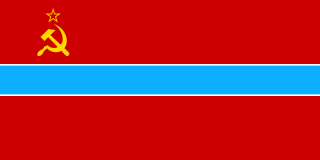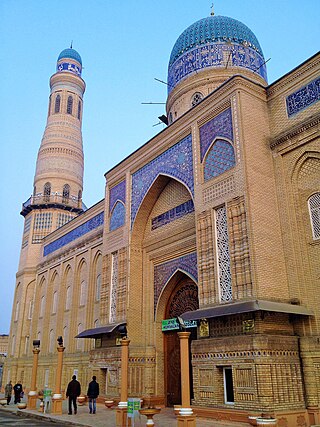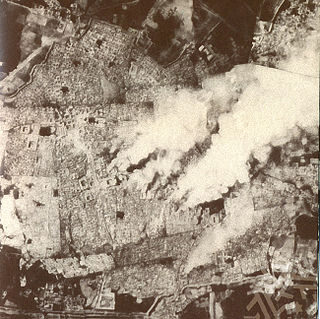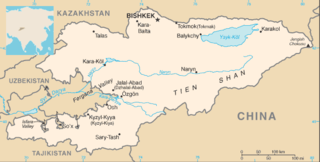Related Research Articles

The Fergana Valley in Central Asia lies mainly in eastern Uzbekistan, but also extends into southern Kyrgyzstan and northern Tajikistan.

The Uzbek Soviet Socialist Republic, also known as Soviet Uzbekistan, the Uzbek SSR, UzSSR, or simply Uzbekistan and rarely Uzbekia, was a union republic of the Soviet Union. It was governed by the Uzbek branch of the Soviet Communist Party, the legal political party, from 1925 until 1990. From 1990 to 1991, it was a sovereign part of the Soviet Union with its own legislation.

Andijan is a city in Uzbekistan. It is the administrative, economic, and cultural center of Andijan Region. Andijan is a district-level city with an area of 74 km2 (29 sq mi). Andijan is the most densely populated city and it had 547,800 inhabitants in 2022. Andijan is located in a tense border region at the south-eastern edge of the Fergana Valley near Uzbekistan's border with Kyrgyzstan.

The Basmachi movement was an uprising against Russian Imperial and Soviet rule in Central Asia by rebel groups inspired by Islamic beliefs.

Fergana, or Ferghana, is a district-level city and the capital of Fergana Region in eastern Uzbekistan. Fergana is about 420 km east of Tashkent, about 75 km southwest of Andijan, and less than 20 km from the Kyrgyzstan border. Fergana is becoming one of the main tourist attractions with more night clubs and night life, being the border city to Kyrgyzstan the city attracts more foreigners to the city. The modern city was founded in 1876.

Osh is the second-largest city in Kyrgyzstan, located in the Fergana Valley in the south of the country and often referred to as the "capital of the south". It is the oldest city in the country and has served as the administrative center of Osh Region since 1939. The city has an ethnically mixed population of 322,164 in 2021, comprising Kyrgyz, Uzbeks, Ukrainians, Koreans, and other smaller ethnic groups.

Russian Turkestan was the western part of Turkestan within the Russian Empire’s Central Asian territories, and was administered as a Krai or Governor-Generalship. It comprised the oasis region to the south of the Kazakh Steppe, but not the protectorates of the Emirate of Bukhara and the Khanate of Khiva. It was populated by speakers of Russian, Uzbek, Kazakh, Kyrgyz, and Tajik.

This article discusses the administrative-territorial division of the Republic of Uzbekistan. The Article 68 of the constitution of Uzbekistan defines:
The Republic of Uzbekistan shall consist of regions, districts, cities, towns, settlements, kishlaks and auls (villages) in Uzbekistan and the Republic of Karakalpakstan.

Osh Region is a region (oblast) of Kyrgyzstan. Its capital is Osh, which is not part of the region. It is bounded by (clockwise) Jalal-Abad Region, Naryn Region, China (Xinjiang), Tajikistan, Batken Region, and Uzbekistan. Its total area is 28,934 km2 (11,171 sq mi). The resident population of the region was 1,391,649 as of January 2021. The region has a sizeable Uzbek minority.

Abdukadyr Urazbekov was the Chairman of the Presidium of the Central Executive Committee of the Kirghiz ASSR (1927–1937) and the first Chairman of the Central Executive Committee of the Kirghiz Soviet Socialist Republic (1937).

Soviet Central Asia was the part of Central Asia administered by the Soviet Union between 1918 and 1991, when the Central Asian republics declared independence. It is nearly synonymous with Russian Turkestan in the Russian Empire. Soviet Central Asia went through many territorial divisions before the current borders were created in the 1920s and 1930s.

Fergana International Airport is a small airport serving the city of Fergana, the capital city of Fergana Region in Uzbekistan. It is one of the biggest airports in Uzbekistan after Tashkent International Airport, Samarkand International Airport and Namangan International Airport

The Great Fergana Canal is an irrigation canal located on the Fergana Valley between Uzbekistan and Tajikistan in Central Asia. The project was constructed in 1939 by 160,000 Uzbek and Tajik collective farm workers from the former Soviet Union and was completed in forty-five days. The canal is 270 kilometers long with over 1,000 hydrotechnical plants located along the waterway, 50 of which are known to be significantly important.

Shohimardon is a village and a subdivision of Fergana District, Fergana Region in eastern Uzbekistan. It is an exclave of Uzbekistan, surrounded by Kyrgyzstan, in a valley in the Pamir-Alay mountains. The name means ‘King of Men’ in Persian. The river Shohimardonsoy flows through the exclave. There are two villages: Shohimardon and Yordon.

The Syr-Darya Oblast was one of the oblasts of the Russian Empire, a part of Russian Turkestan. Its center was Tashkent.
The Uzbek Ground Forces are the land component of the Armed Forces of the Republic of Uzbekistan. Operating since the collapse of the Soviet Union in 1991, the army is made up of former Soviet Army units that were in the territory of Uzbekistan. As of 2006, it had around 40,000 active personnel. Much of the equipment it uses is also old Soviet material, and the government of Uzbekistan has not given much effort to replace it with modern equipment.
The 62nd Rifle Division was an infantry division of the Soviet Union's Red Army, formed four times and active during World War II and the postwar period. The division was formed in 1936 and fought in the Winter War and Soviet occupation of Bessarabia and Northern Bukovina. It was destroyed during the Battle of Kiev in summer 1941. The division was reformed in November 1941. It fought in the defense against the German offensive Case Blue during the summer of 1942. After suffering heavy losses, it was withdrawn from combat but was sent back to fight in the Battle of Stalingrad in November. The division suffered heavy losses and was disbanded on 2 November. The division was reformed a third time from a rifle brigade in April 1943. It fought in Operation Suvorov, Operation Bagration, the East Prussian Offensive and the Prague Offensive. It was disbanded in the summer of 1945. The 62nd was reformed a fourth time by renaming the 360th Rifle Division, but became the 108th Motor Rifle Division in 1957.
This name uses Eastern Slavic naming customs, the patronymic is Majitovich and the surname is Abdullaev.

The Kyrgyzstan–Uzbekistan border is 1,314 kilometres (816 mi) in length and runs from the tripoint with Kazakhstan to the tripoint with Tajikistan. It is Kyrgyzstan's longest external boundary.

The Turkestan Autonomy or Kokand Autonomy was a short-lived state in Central Asia that existed at the beginning of the Russian Civil War. It was formed on 27 November 1917 and existed until 22 February 1918. It was a secular republic, headed by a president.